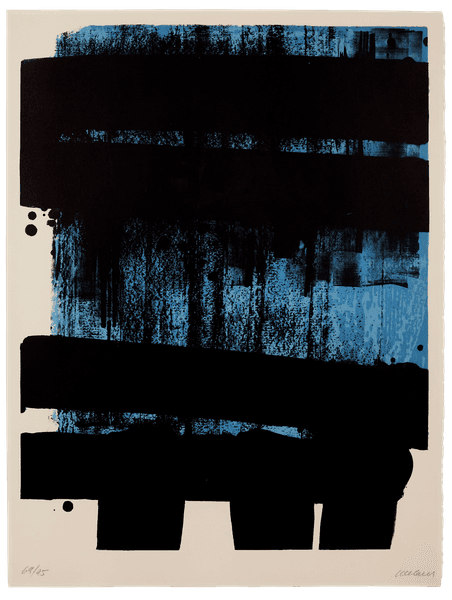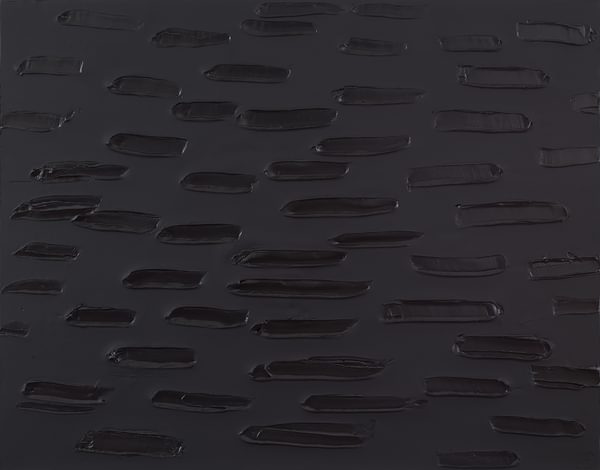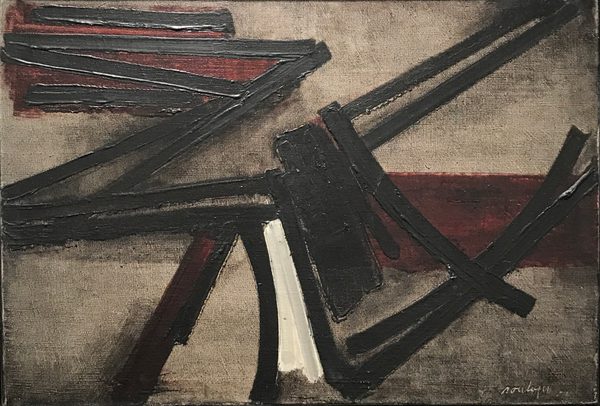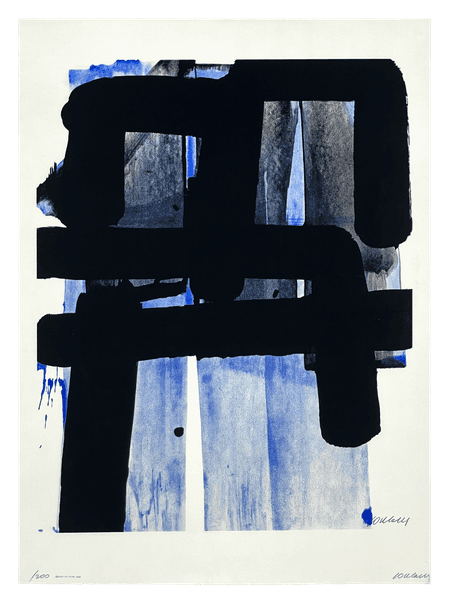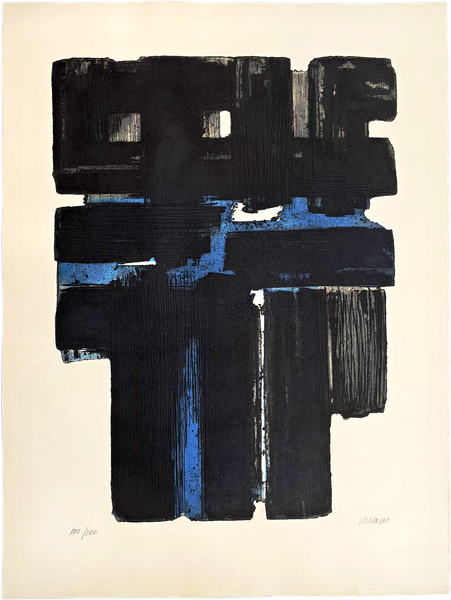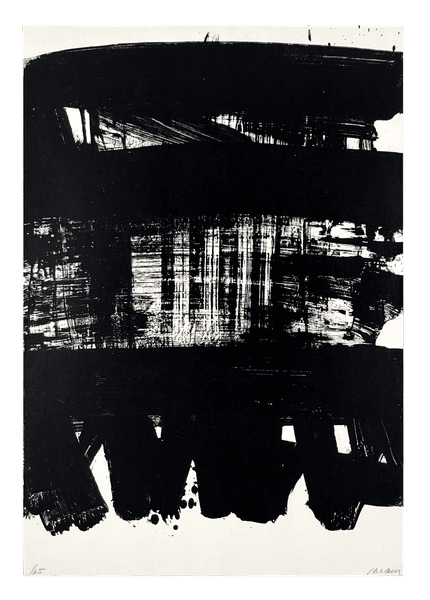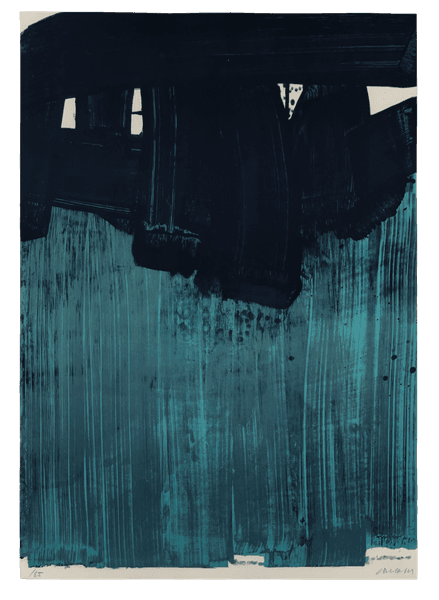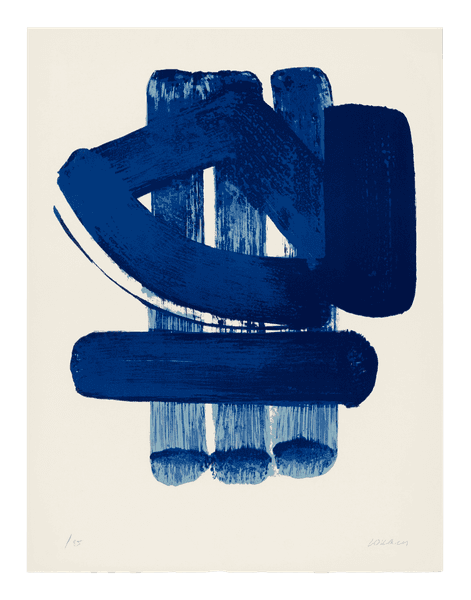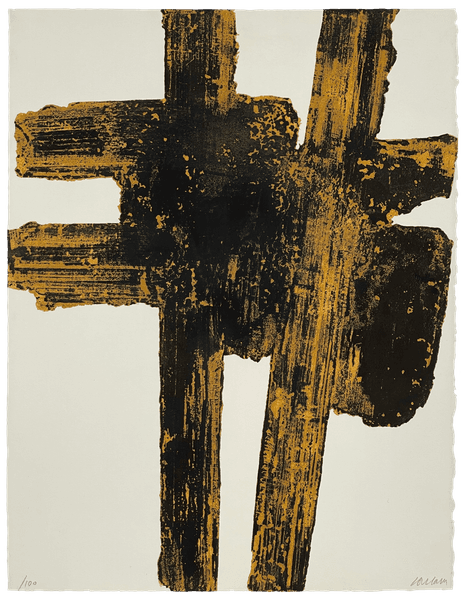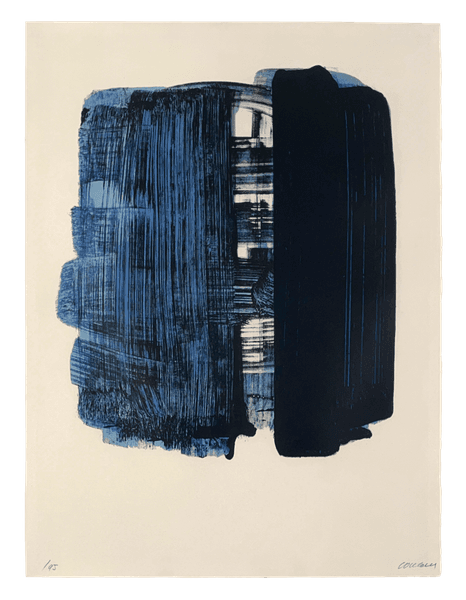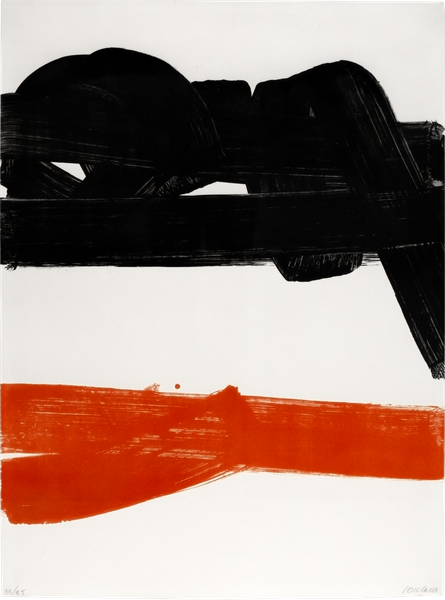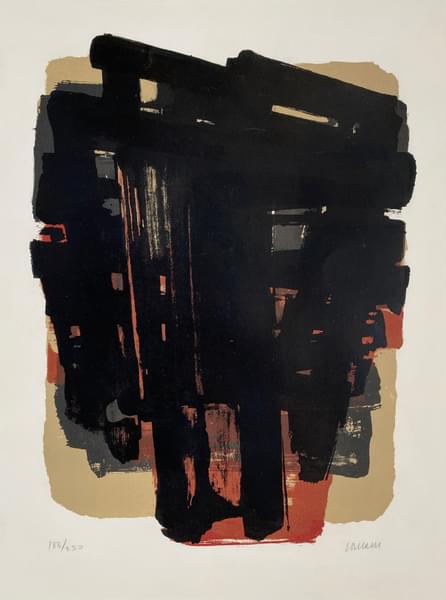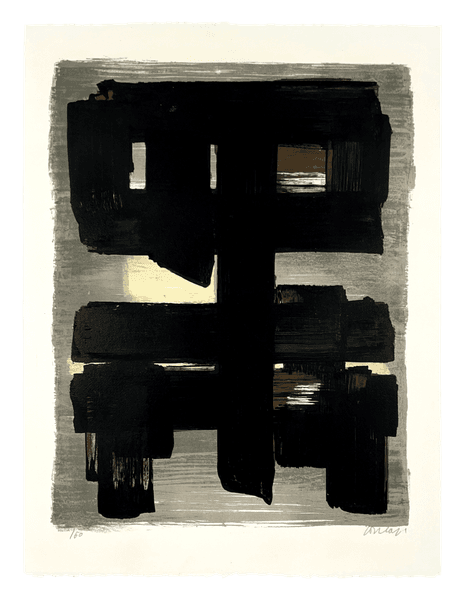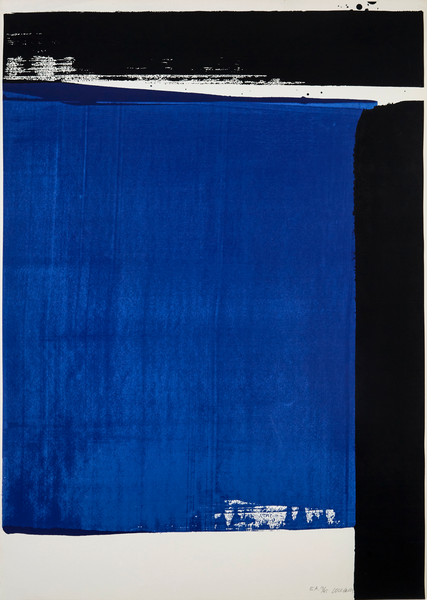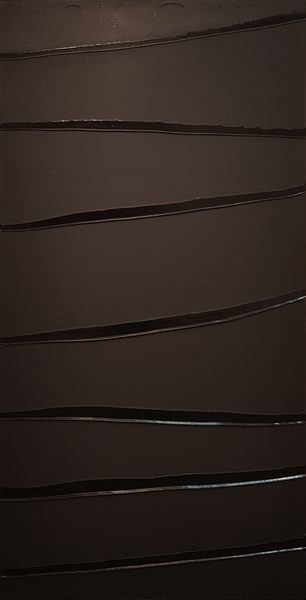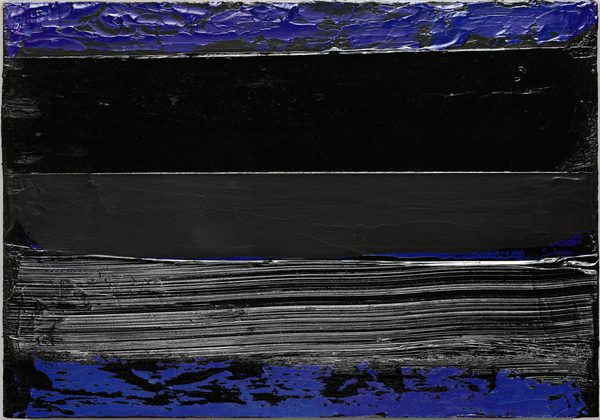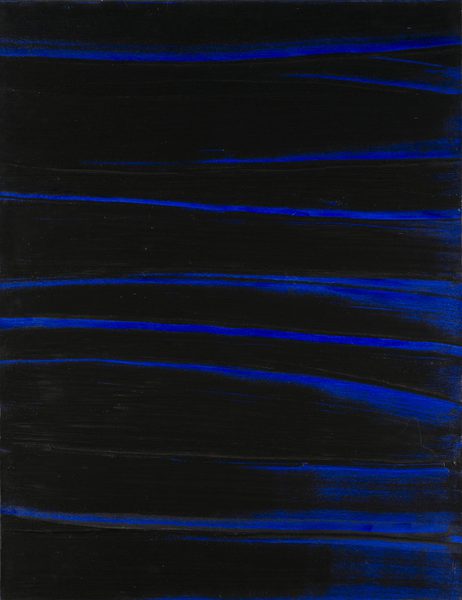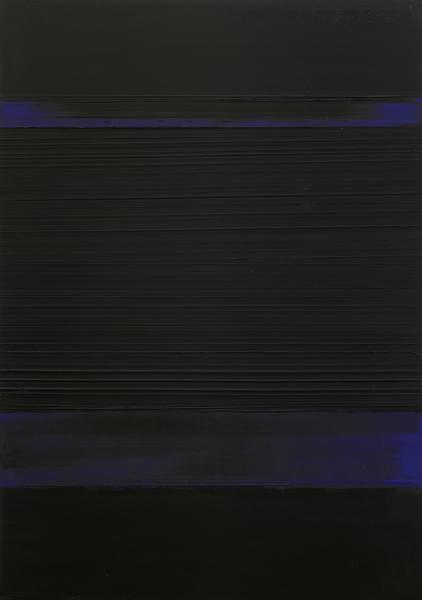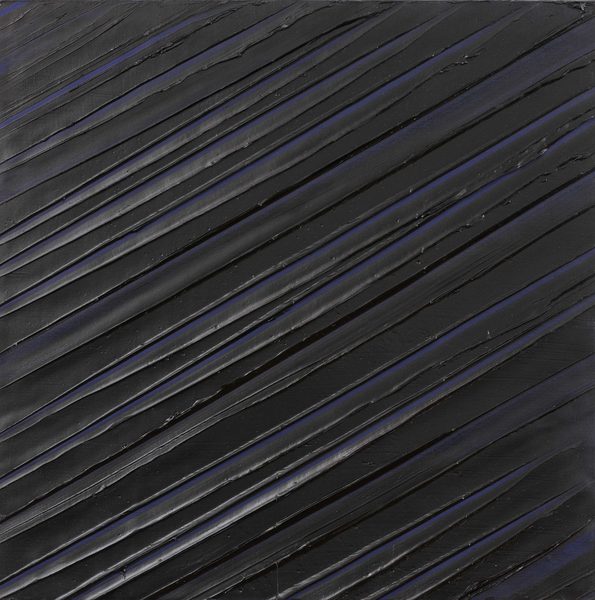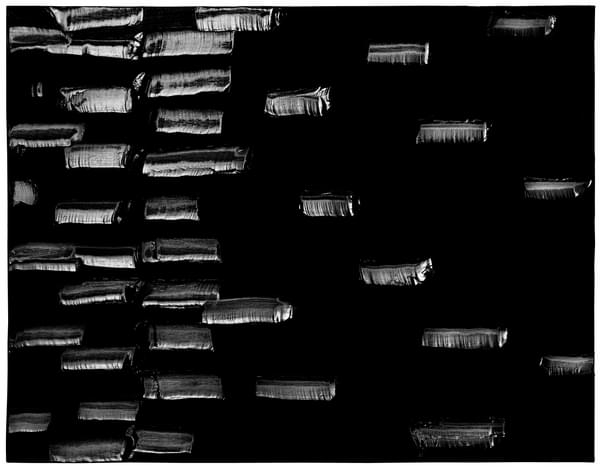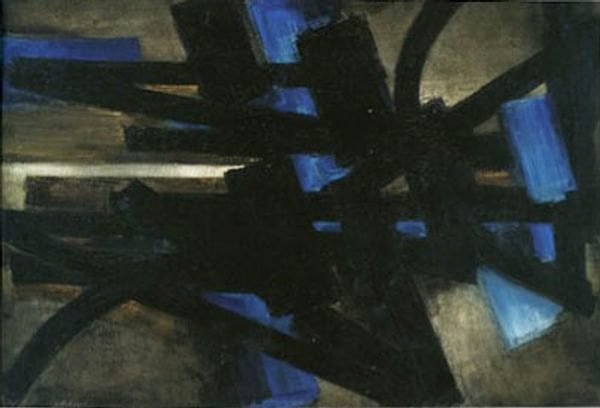Eau-forte XVIII
One day, whilst working and learning the Eau-forte (etching and aquatint) printing technique in Lacourière’s studio, Soulages made an accidental discovery which changed his outlook entirely.
Soulages’ natural etching style had been to scrape away the varnished surface to expose the copper plate, in gestures that moved back towards him, rather than to incise by way of a pushing motion. When a design had begun to take shape, the copper plate would be bathed in acid and the acid would bite where the copper had been exposed, deepening the gestures. Soulages would let prolonged acid exposure become part of the creative process, achieving random effects which the artist found pleasing and would work with and around. The deeper the cavities in the plate, the greater would be the eventual ink load on the paper. Roger Lacourière cautioned Soulages against going too far, “as long as there is copper Pierre, there is hope.” The inevitable happened though. The artist went too far and the acid ate through the copper plate in places. Lacourière shook his head, laughed and told Soulages that, as far as that particular plate was concerned, “it’s over.”
“I”, recalled Soulages, “a little out of spite and a little out of curiosity, I printed the plate with the hole I had made and the realised a great thing that I could not have foreseen. When the paper is pressed on a copper plate, under the press, which is a kind of rolling mill, the flesh of the paper is no longer the same, it has become smooth, burnished by the copper. Where the copper has been holed, the paper is spared, it keeps its paper life and I found it beautiful. The hole I made left white paper, but it was not the same white…because of the contrasts with the surrounding colours it seemed even whiter.”
Soulages extended this practice by removing parts of the copper plate so that it no longer had a rectangular border, "Why should a rectangular sheet of paper still be printed with a rectangle?" For some prints the artist would use more than his own bodyweight in acid to achieve the depth of ink saturation he strived for, in his words “provoking the material, bringing out surprises, unforeseen events, taking risks and seizing chances.” In this way his printmaking kept pace with his painting practice which was, after all, a long journey towards black. Working in this way became a source of great satisfaction for Soulages, who had finally found how to make prints in the way he approached his paintings, creating material form and colour at the same time. Soulages worked also in lithograph and in silkscreen, and in each medium he managed to deviate from the normal established practices, seizing on chance effects and developing them in ways that had not been previously explored. He would work directly on printed proofs, adjusting them before printing them again, constantly developing his imagery and increasing the scale of the sheets on which he worked.
Eau-forte XVIII
- Artist
- Pierre Soulages (1919-2022)
- Title
- Eau-forte XVIII
- Medium
- Etching and aquatint on Arches paper
- Date
- 1962
- Size
- 25 ½ x 19 ½ in : 64.5 x 49.0 cm
- Framed size
- 27 ¾ x 21 ¾ in : 70.3 x 55.3 cm
- Edition
- From the edition of 100
- Inscriptions
- Signed and numbered by the artist in pencil
- Printer
- Printed by Lacourière, Paris
- Publisher
- Published by Berggruen, Paris
- Exhibited
- Pierre Soulages. Une Lumière Infinie. Phillips X in collaboration with ARCHEUS / POST-MODERN, 30 Berkeley Square, London, 1 – 12 February 2023; Radical - A Pierre Soulages & Lee Ufan Dialogue, Perrotin, Paris, October - December 2023
- Literature
- "Soulages l'œuvre imprimé", Pierre Encrevé & Marie-Cécile Miessner, Bibliothèque nationale de France, 2003, Cat. 19 (col. illus. pl. 20) and indexed p.186
"Soulages Eaux-fortes, lithographies 1952-1973", Yves Rivière, Arts et Métiers Graphiques, Paris, 1974, no. XVIII (b/w illus.) pp.62-63 - Reference
- A22-47
- Download PDF
- Status
- Available
Available Artists
- Albers Anni
- Ancart Harold
- Andre Carl
- Avery Milton
- Baldessari John
- Barnes Ernie
- Calder Alexander
- Castellani Enrico
- Clough Prunella
- Crawford Brett
- Dadamaino
- de Tollenaere Saskia
- Dyson Julian
- Elsner Slawomir
- Freud Lucian
- Gadsby Eric
- Gander Ryan
- Guston Philip
- Haring Keith
- Hartung Hans
- Hayes David
- Held Al
- Hepworth Barbara
- Hill Anthony
- Hitchens Ivon
- Hockney David
- Hutchinson Norman Douglas
- Jenney Neil
- Katz Alex
- Kentridge William
- Knifer Julije
- Kusama Yayoi
- Le Parc Julio
- Leciejewski Edgar
- Léger Fernand
- Levine Chris
- Marchéllo
- Martin Kenneth
- Mavignier Almir da Silva
- Miller Harland
- Mitchell Joan
- Modé João
- Moore Henry
- Morellet François
- Nadelman Elie
- Nara Yoshitomo
- Nesbitt Lowell Blair
- Nicholson Ben
- O'Donoghue Hughie
- Pasmore Victor
- Perry Grayson
- Picasso Pablo
- Pickstone Sarah
- Prehistoric Objects
- Riley Bridget
- Ruscha Ed
- Sedgley Peter
- Serra Richard
- Shrigley David
- Smith Anj
- Smith Richard
- Soto Jesús Rafael
- Soulages Pierre
- Spencer Stanley
- Taller Popular de Serigrafía
- The Connor Brothers
- Vasarely Victor
- Vaughan Keith
- Whiteread Rachel
- Wood Jonas

